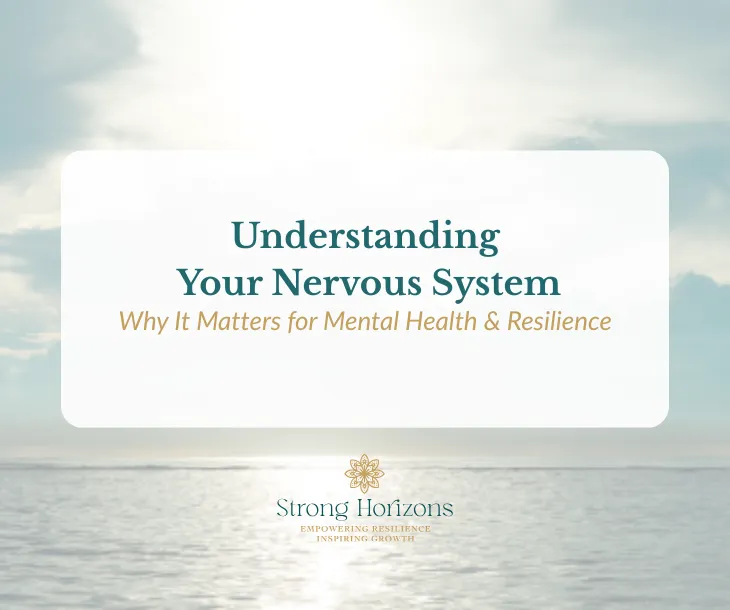
Understanding Your Nervous System: Why It Matters for Mental Health & Resilience
"Understanding Your Nervous System: Why It Matters for Mental Health & Resilience"- Sally MacDonald
Have you ever wondered why your heart races before a difficult conversation, your stomach tightens during stress, or your mind goes completely blank just when you need it most?
These reactions aren’t signs of weakness — they’re signs that your nervous system is doing its job. It’s working hard to keep you safe.
Understanding how your nervous system works is one of the most powerful ways to improve mental health, emotional balance, and resilience — both personally and professionally.
Your Built-In Alarm and Safety System
The nervous system is like your body’s internal surveillance network. It constantly scans for cues of safety or danger, deciding whether you can relax, engage, and think clearly — or whether you need to protect yourself.
When your body senses threat (real or perceived), it automatically activates stress responses such as:
Fight: anger, frustration, control
Flight: anxiety, overworking, avoidance
Freeze: feeling stuck, disconnected, unable to think
These responses aren’t conscious choices — they’re automatic survival strategies shaped by your biology and life experiences.
The more pressure, trauma, or chronic stress we experience, the easier it becomes for the body to stay “switched on” — even when we’re not in immediate danger.
When the System Stays on High Alert
Your nervous system is designed to protect you — but it was never meant to stay in protection mode for long.
When we live or work under ongoing pressure, our body can begin to treat everyday challenges as potential threats.
The same survival responses that once kept us safe can then start to drain our energy and affect our physical and emotional health.
You might notice:
Physically: tension headaches, digestive discomfort, fatigue, sleep disruption, racing heart, or recurrent pain.
Emotionally: anxiety, irritability, numbness, or feeling “on edge” for no clear reason.
Mentally: difficulty concentrating, overthinking, forgetfulness, or sudden blank moments in stress.
Behaviourally: overworking, withdrawing, or turning to quick fixes like scrolling, eating, or staying constantly busy.
These are not signs of weakness — they’re signals that your system has been doing too much for too long.
Recognising these patterns with compassion is the first step towards restoring a sense of self, steadiness, and safety.
Regulation: The Foundation of Resilience
Resilience isn’t about staying calm all the time or pushing through stress — it’s about how quickly and safely we can return to balance after being triggered or overwhelmed.
That process is called self-regulation.
When your nervous system is regulated, your body and mind can communicate effectively. You can think clearly, make grounded decisions, and connect with others. When it’s dysregulated, it’s much harder to perform, lead, or even care for ourselves and those around us.
This is why understanding the nervous system is so valuable in workplaces and communities: it helps us recognise that behind every reaction — ours or someone else’s — is a state of the nervous system, not a personal flaw.
The First Step: Recognising What’s Happening in Your Body
Before we can calm or reset, we need to notice.
Learning to notice your body’s early signals of stress — a racing heart, a shallow breath, a tightening jaw — helps us build awareness of what the body is communicating and gives us space to respond rather than react.
When we can pause and sense these cues, we create the conditions for regulation to happen more naturally.
From Practice to Resilience
Each time we pause, breathe, move, or ground ourselves, we remind the body that it’s safe enough to soften.
These small moments of regulation, repeated over time, teach the nervous system that it can recover and adapt.
There are countless ways to support nervous system regulation — from gentle movement, humming or singing, breathing exercises, and time in nature, to approaches like Emotional Freedom Technique (EFT), mindfulness meditation, the Safe and Sound Protocol (SSP), or even cold-water immersion. The key is finding what helps your body feel safe enough to reset.
That growing capacity to shift out of stress and return to a steadier state is what builds resilience— not perfection, but flexibility — to keep us healthy, happy, and productive.
Continue the Journey — Free Toolkit Download
If you’d like practical tools to help you recognise and regulate your own nervous system, download the free Regulate & Reset Nervous System Toolkit.
It includes:
A simple guide to the three main nervous system states
Early warning signs of stress and dysregulation
Gentle, body-based tools to help you reset in the moment
👉 Download the free toolkit here
Understanding your body’s responses is the first step.
Supporting and strengthening them is where resilience truly grows.
When we learn the language of the nervous system, we stop seeing reactions as “problems to fix” — and start recognising them as messages from the body, guiding us back to safety and balance.
